Review: ‘Blonde’ isn’t really about Marilyn Monroe. It’s about making her suffer
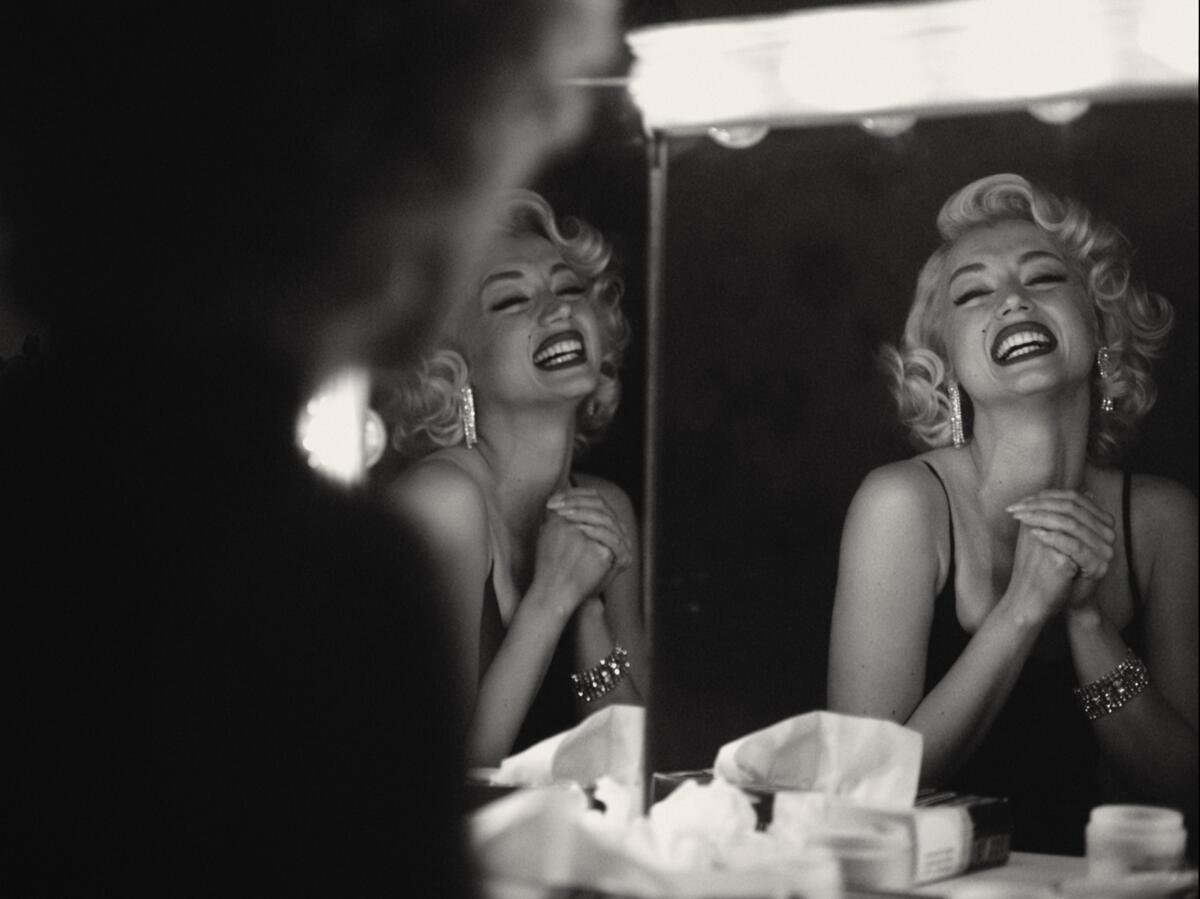
There’s at least one moment in “Blonde,” Andrew Dominik’s dazzling, depressing and fatally incurious movie about Marilyn Monroe, when you might not be sure if you’re watching Ana de Armas or the genuine article. Watching this lustrous black-and-white sequence, set during the production of “Some Like It Hot” (1959), I was briefly certain that was the real Monroe boop-boop-be-dooping her way through “I Wanna Be Loved by You,” so evocatively does De Armas narrow her gaze (her eyes are the big giveaway) and drink in the milky adoration of the spotlight. Only the absence of that teasing shadow on her dress, the one that mimics a rising and falling neckline, gives the game away.
Even in these times of Oscar-grubbing biopic overload, a moment like that has to count as some kind of achievement. It takes more than crimson lips, swiveling hips and a platinum dye job to incarnate this most enduring of 20th century movie stars, even if Monroe was reduced to her physical attributes for too much of her short life and extraordinary career. People insisted she couldn’t act; studios typecast her as a dumb blond, a setback she partly overcame through sly wit and brilliant comic timing. In time, she became an icon, but even that overused word, “icon,” can feel diminishing after a while. It relegates Monroe’s greatness to the level of surfaces and publicity and indiscriminate goddess worship, as if her beauty could be somehow disentangled from her singular greatness — her genius — as an actor.
For your safety
The Times is committed to reviewing theatrical film releases during the COVID-19 pandemic. Because moviegoing carries risks during this time, we remind readers to follow health and safety guidelines as outlined by the CDC and local health officials.
De Armas doesn’t get nearly enough opportunities to tap into that greatness. Radiantly sympathetic in scene after scene, she delivers a strong, intensely felt performance in a movie that doesn’t begin to earn it, that insists on squeezing her sometimes eerie channeling of Monroe’s image into the puniest possible dramatic mold. Dominik seems to have directed De Armas to lead with her tremulous vulnerability, to drift through the movie in blurred states of fragility, anxiety and panic. She steps into pitch-perfect re-creations of vintage Monroe photographs, sometimes fixing us with a half-pleading, half-conspiratorial smile. She does a sustained approximation of Monroe’s breathily seductive voice, sometimes with unmistakable traces of her own Cuban-Spanish accent — a flaw that’s earned some criticism but, if anything, strengthens the movie’s notion of Monroe as a construct, a gorgeous mask that keeps slipping. The superficial imperfections of De Armas’ performance aren’t the problem with “Blonde.” It needs every ounce of her, and her humanity, that it can muster.
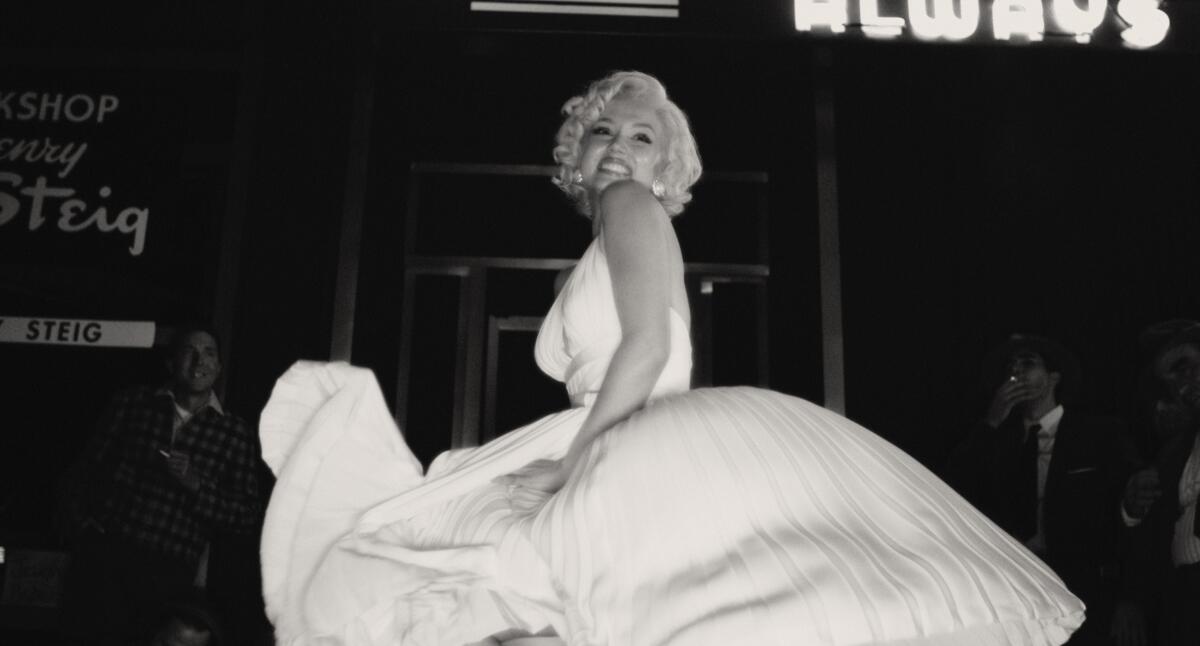
Even the levitational pleasure of that “Some Like It Hot” scene can’t last. Before long, this Marilyn isn’t singing; she’s screaming and flailing and bringing the production to a halt. Dominik doesn’t do much by halves, diva crackups included, and it’s dispiriting to realize that this is why he bothered with this particular Hollywood re-creation. Monroe, then just four years away from her death of a barbiturate overdose at age 36, was already deep in the throes of addiction; stories of her difficulty remembering her lines (and her less-than-collegial treatment by Tony Curtis, Jack Lemmon and Billy Wilder) are legion. It couldn’t matter less to Dominik that she wound up giving one of her greatest, funniest performances anyway. What matters is the chance to unleash Monroe’s many demons — a miserable childhood, a rapacious industry, a cavalcade of bad, brutalizing men — and bring them rushing to the surface, not for the first or final time.
In “Blonde,” Monroe’s pain is never final. The insults, the abandonments, the beatings, the rapes, the addictions, the losses of consciousness and selfhood — these aren’t just cruel twists or setbacks; they’re the movie’s organizing principles. With a meticulous command of craft and the kind of high seriousness that only a nearly three-hour running time can signify, Dominik sets out to chronicle the many degradations that were inflicted on Monroe’s body and spirit, plus a few that probably weren’t. (His blueprint is Joyce Carol Oates’ 2000 novel of the same title.) Like his great 2007 western, “The Assassination of Jesse James by the Coward Robert Ford,” “Blonde” has been conceived as a slow-motion death march: “The Assassination of Marilyn Monroe by Basically Everyone She Ever Met.” And in every aesthetic detail, from the brooding undertow of Nick Cave and Warren Ellis’ score to the artfully arbitrary mix of color and black-and-white in Chayse Irvin’s boxily framed images, “Blonde” styles itself as a work of rare, unflinching honesty — a nightmarish plunge into the Hollywood abattoir that ground up and finally devoured its most sublime creation.
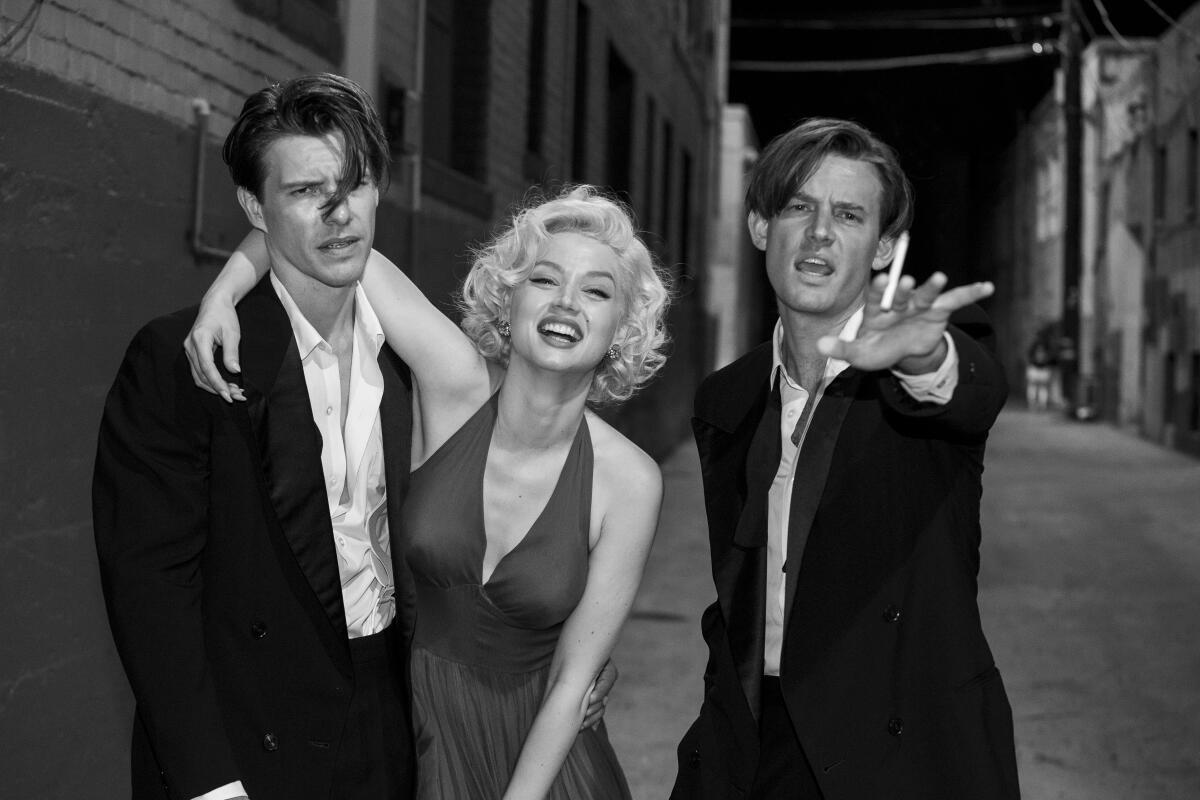
Any truthful portrait of Norma Jeane Baker, the woman who became Marilyn Monroe, would of course have to reckon with the tightly coiled double helix of her art and her tragedy. But “Blonde” is all tragedy, and its single-mindedness isn’t just dull and punishing but also wearyingly unimaginative. That’s not something I would say about Oates’ novel, a sprawling demolition of the Monroe mythos that, by freely revising and departing from the biographical record, arrives at its own tough truths about its subject. Framed as a sordid 20th century fairy tale, it achieves a far richer, more expansive kind of portraiture than this blunt instrument of a movie ultimately manages.
Something seems off from the hasty opening scenes of Norma Jeane (an affecting Lily Fisher) growing up in early 1930s Los Angeles with her volatile mother, Gladys (Julianne Nicholson, fierce), who’s soon diagnosed with paranoid schizophrenia and institutionalized. Developments that consumed chapters of the book — Norma Jeane’s time in an orphanage and foster care, her short-lived first marriage at age 16 — are omitted entirely, which isn’t a deal breaker; even at two hours and 45 minutes, “Blonde” can’t be expected to accommodate the density of a 700-plus-page narrative. But it’s what Dominik chooses to do — and not do — with those two hours and 45 minutes that suggests a bigger problem than basic compression issues.
The movie skips ahead to Norma Jeane’s early modeling days (enter De Armas in a breezy pinup montage), which in turn open the door to an acting career. Unfortunately, that door leads into the office of a studio mogul who lifts her skirt, sexually assaults her and then sends her briskly on her way — a scene that’s set, with startlingly jejune crudeness, to “Ev’ry Baby Needs a Da-Da-Daddy.” That song choice is one of many numbing references to the gaping father wound she’s borne since childhood, ever since her mother implied that Norma Jeane’s never-seen father was himself a famous Hollywood actor. Even as she rises to new heights of fame if not necessarily fortune (like a lot of studio contract players, Monroe was grossly underpaid), she keeps scanning the crowds for the man she believes has been watching and protecting her from afar.
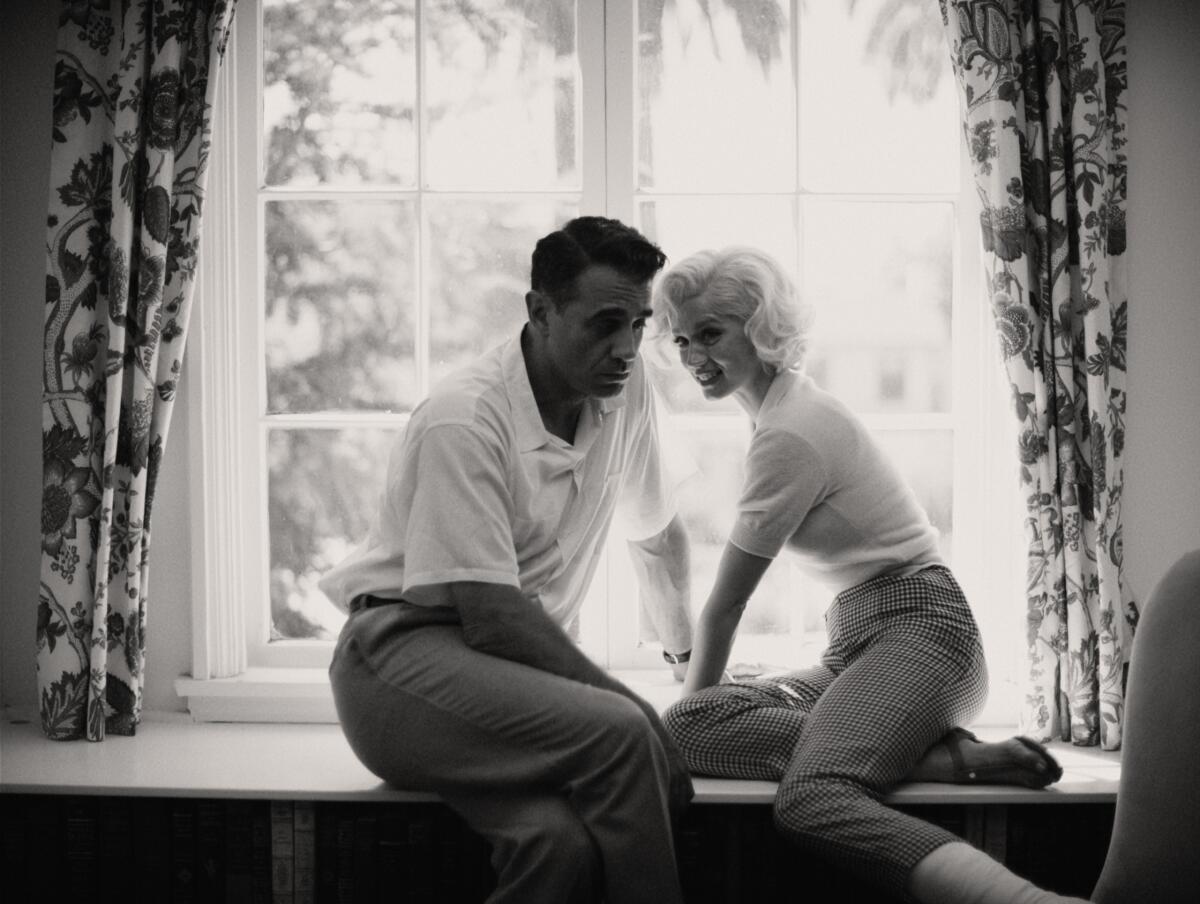
This lays the emotional groundwork for just about every bad romance that lies ahead. She falls into a tabloid-titillating threesome with two hunky Hollywood scions, Charlie “Cass” Chaplin Jr. (Xavier Samuel) and Edward “Eddy” G. Robinson Jr. (Evan Williams), both nursing daddy issues of a different kind. This subplot, one of the novel’s weirder fabrications, coincides with Norma Jeane’s full public emergence as Marilyn, which soon draws her toward older, higher-profile suitors. “Daddy” turns out to be Norma Jeane’s preferred term of endearment for husbands Joe DiMaggio (Bobby Cannavale), who smacks her around and resents her fame, and Arthur Miller (Adrien Brody), who treats her with more tenderness, if also the same lofty condescension she gets from everyone else.
Norma Jeane’s mommy issues are an equivalent source of torment; she’s desperate to have a child and become the kind of stable, supportive mother she herself never had. To that end, I guess, Dominik visualizes her failed pregnancies — one ends in an abortion, another in a miscarriage — as tragedies of a cosmic order. In goes the surreally invasive utero-cam; out come the kitschy images of a fetus glowing inside Norma Jeane’s womb. (The Star Child in “2001” didn’t exude this much celestial wonderment.) But if “Blonde” boasts some of the most gynecological mise-en-scène this side of Gaspar Noé’s “Enter the Void,” that’s nothing compared with the nadir of a scene in which an older, wearier Norma Jeane is dumped like a sack of meat in President Kennedy’s hotel suite. The violation that follows, which likely accounts for the movie’s NC-17 rating, has an in-your-face ugliness that wants to be seen as courageously unadorned, but all the scene really does is wallow, to no moral or intelligent purpose, in the spectacle of Monroe’s debasement.
Salacious rumors have been swirling around “Blonde” since well before its recent Venice International Film Festival premiere, but pre-release controversy was always to be expected of a movie about a Hollywood star who’s lost none of her tragic mystique 60 years after her death. The outrage that greeted Kim Kardashian when she wore Monroe’s historic “Happy Birthday, Mr. President” gown to this year’s Met Gala was a reminder of the feverish protectiveness the actor can still inspire. It was also a reminder of how often that protectiveness expresses itself through the trappings and accouterments of an endlessly reproducible image — an image that, according to “Blonde,” so consumed and obscured the real Norma Jeane that it ultimately obliterated her.
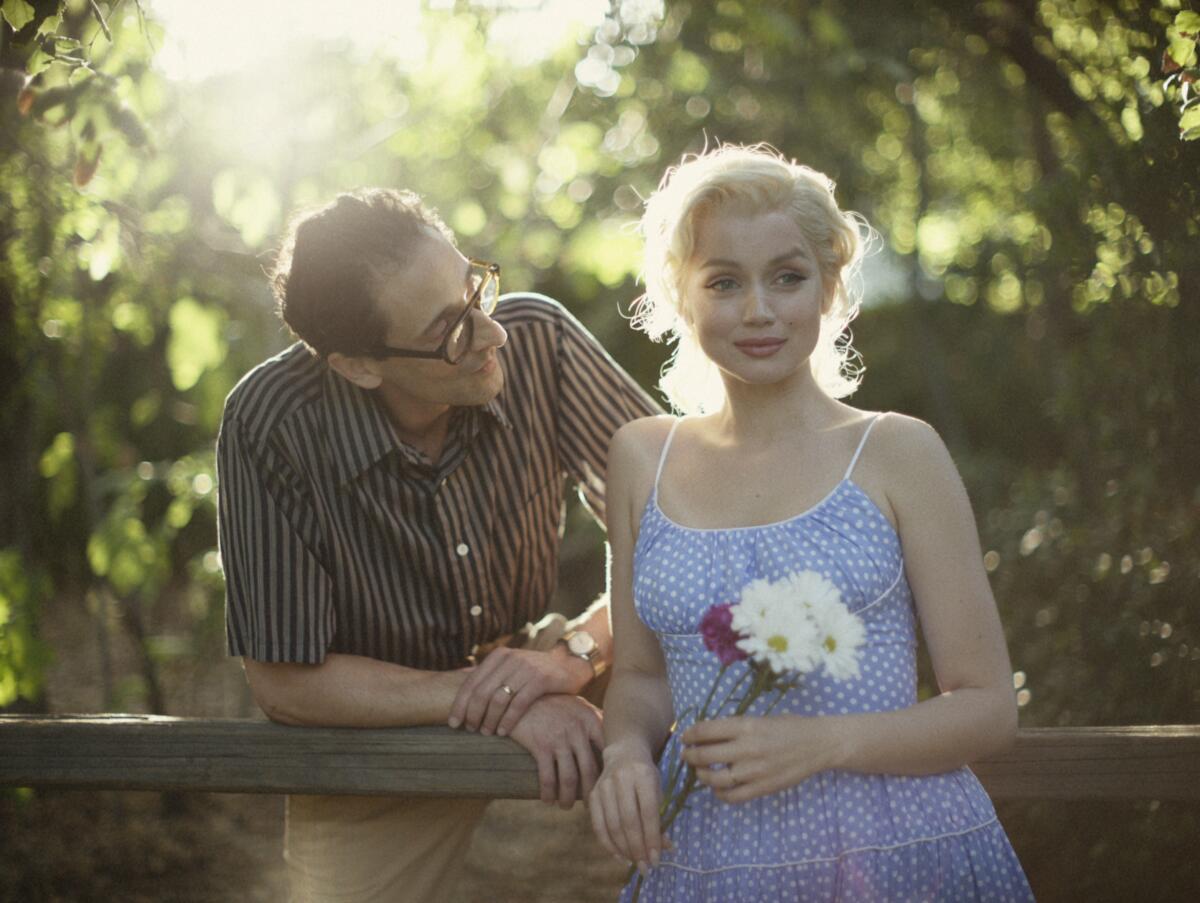
“That thing up on the screen, it isn’t me,” she murmurs when she sees herself perform “Diamonds Are a Girl’s Best Friend,” and you understand her alienation from the defining 20th century sex symbol she’s fast becoming. But in “Blonde’s” clumsy hands, even that legitimate insight feels too easy. Her star persona may have been a glittering Hollywood construct, but to suggest that Marilyn Monroe had no hand in the creation of Marilyn Monroe is to deny her a very specific form of agency, and I don’t mean William Morris. Because Dominik can’t conceive of Monroe as anything but a victim, he can’t even grant her the respect of seeing her as, at the very least, a participant in her success and her undoing. A smarter, tougher movie would have explored that participation and recognized it as its own kind of power — a power as undeniable as the allure of the movies themselves.
“Blonde” seems blind to that allure, even scornful of it. There’s no sense of Monroe the brilliant screen comedian, the joyous cinematic life force. Instead, Dominik operates by a simplistic dramatic equation that ties her greatest professional highs to her worst personal lows: How could Marilyn — or anyone, really — take any joy in the applause for “Gentlemen Prefer Blondes,” when all she can think about is her guilt over her studio-ordered abortion? Why should her famous interaction with a subway grate in “The Seven Year Itch” be anything but a windy metaphor for all the lecherous hounds of Hollywood, driven home — in case we missed the point — by all those men leering at her from the crowd, flashbulbs popping like gunfire?
“In the movies, they chop you all to bits: cut, cut, cut,” Norma Jeane says. She’s contrasting film acting, where performances are often pieced together in the editing room, with the stage acting that she aspires to do; she’s also expressing a level of aesthetic and intellectual curiosity that earns her the usual sneering dismissals. But “Blonde” subjects Monroe to its own grisly vivisection. It lays the most betrayed, abused and vulnerable parts of her out across the screen and chucks the rest away: her talent, her magnetism, her smarts, her guts. “Blonde” can be remarkably cruel, but really, it’s not all that remarkable. It won’t be the first movie, or the last, that Marilyn Monroe outlives.
‘Blonde’
Rating: NC-17, for some sexual content
Running time: 2 hours, 46 minutes
Playing: In limited release; starts streaming Sept. 28 on Netflix
More to Read
Only good movies
Get the Indie Focus newsletter, Mark Olsen's weekly guide to the world of cinema.
You may occasionally receive promotional content from the Los Angeles Times.











